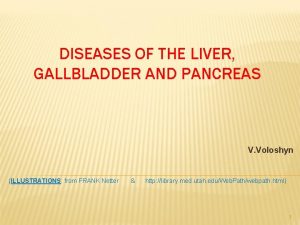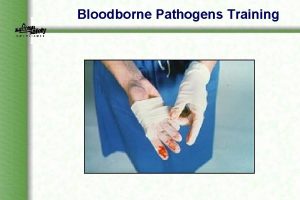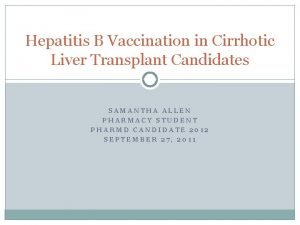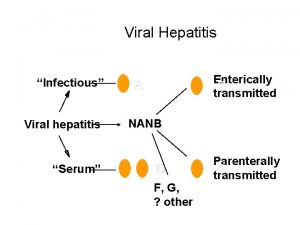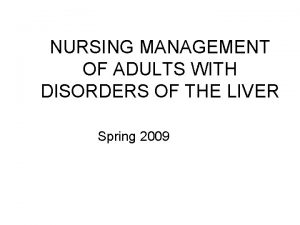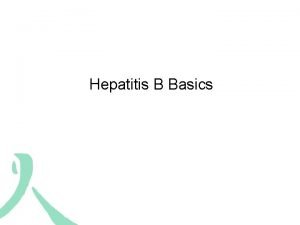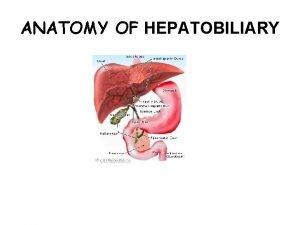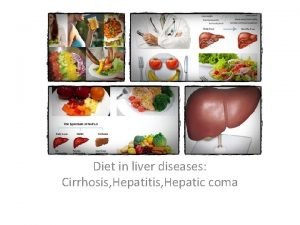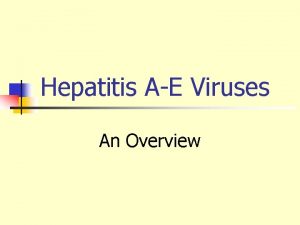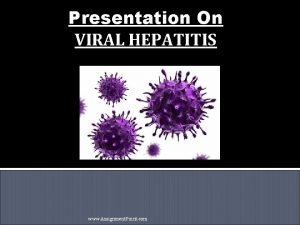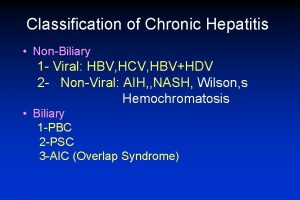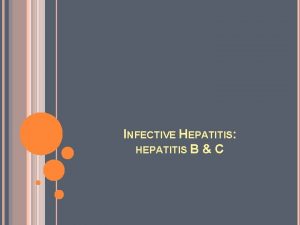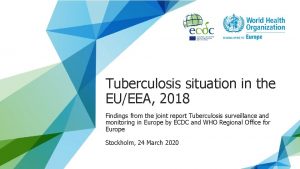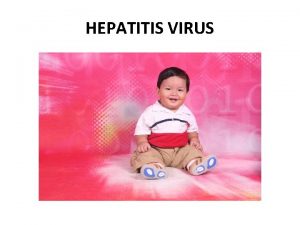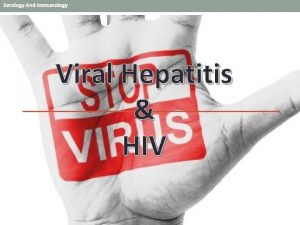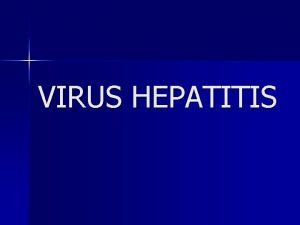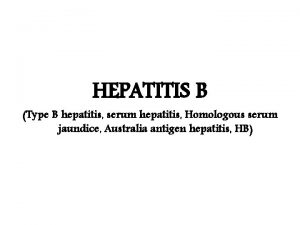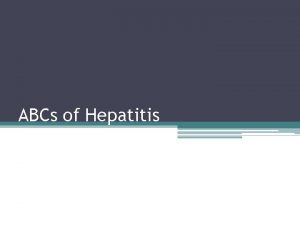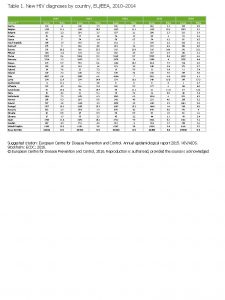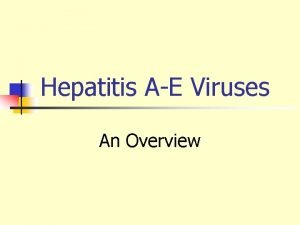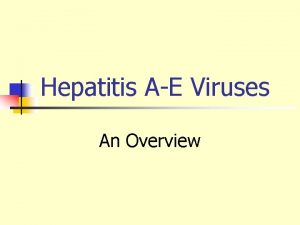Situation overview on hepatitis E in the EUEEA























- Slides: 23

Situation overview on hepatitis E in the EU/EEA Member States

Surveillance of hepatitis E in Europe • One of the most common causes of acute hepatitis in the EU/EEA • Evidence of increasing number of autochthonous cases in Europe • Hepatitis E is notifiable at EU level • Populations under surveillance, case definitions and reporting systems, are set by Member States

Key objectives of current work at EU level on HEV • To describe national surveillance systems, case definitions and laboratory methods for diagnosis • To collect case numbers, where possible, to describe epidemiology, burden and severity (clinical picture) across Europe • To describe populations at risk • To explore rationale and objectives of national hepatitis E surveillance

ECDC activities 2015– 2019 • Establishment of an expert group Members are nominated experts from the EU/EEA MS + 3 external scientific experts + EFSA + WHO • EU/EEA Member State survey Surveillance systems, applied case definitions and laboratory methods for diagnosis, collect case numbers • Support of a voluntary centralised sequence data repository Facilitate communication, support development and first HEVnet meeting https: //eurosurveillance. org/content/10. 2807/1560 -7917. ES. 2019. 24. 10. 1800407 • Expert opinion on national surveillance standards

Hepatitis E virus: Assessment of the epidemiological situation in humans in Europe, 2014/15 Available from: https: //www. sciencedirect. com/science/article/pii/S 1386653216301433? via%3 Dihub 5

Presentations from ECDC expert group meetings, 2015 and 2018 https: //www. slideshare. net/tag/ecdc-hev-meeting-2015 6

https: //ecdc. europa. eu/en/publications-data/hepatitis-e-eueea-2005 -2015 https: //eurosurveillance. org/content/10. 2807/1560 -7917. ES. 2017. 22. 26. 30561 EU/EEA Member State survey 7

Emergence and surveillance of hepatitis E in humans, EU/EEA, 2005– 2015 Study objective: Provide an overview of national surveillance systems, applied case definitions, laboratory methods for diagnosis, and numbers of confirmed HEV cases across the EU/EEA https: //ecdc. europa. eu/en/publications-data/hepatitis-e-eueea-2005 -2015 https: //eurosurveillance. org/content/10. 2807/1560 -7917. ES. 2017. 22. 26. 30561

Methods • Questionnaire developed and piloted with participants at an ECDC HEV expert group meeting • Electronic PDF survey sent to all 31 Member States • Response from 30/31 EU/EEA countries • Descriptive analysis of surveillance systems, number of cases by age, gender, hospitalisation status, number of deaths https: //ecdc. europa. eu/en/publications-data/hepatitis-e-eueea-2005 -2015 https: //eurosurveillance. org/content/10. 2807/1560 -7917. ES. 2017. 22. 26. 30561

HEV surveillance systems in EU/EEA, 2015 20 EU/EEA countries with HEV-specific surveillance https: //ecdc. europa. eu/en/publications-data/hepatitis-e-eueea-2005 -2015 https: //eurosurveillance. org/content/10. 2807/1560 -7917. ES. 2017. 22. 26. 30561

HEV case definitions in EU/EEA surveillance systems Case definitions varied across countries, two countries with case definitions for chronic cases https: //ecdc. europa. eu/en/publications-data/hepatitis-e-eueea-2005 -2015 https: //eurosurveillance. org/content/10. 2807/1560 -7917. ES. 2017. 22. 26. 30561

Number of laboratory-confirmed cases of HEV by year and start of surveillance, 22 EU/EEA Member States, 2005– 2015* • 10 -fold increase 2005– 2015 due locally acquired infections • 78% of cases reported from France, Germany and UK * Data available for: Austria, Belgium, Bulgaria, Croatia, Cyprus, Czech Republic, Estonia, Finland, France, Germany, Hungary, Italy, Latvia, Netherlands, Norway, Poland, Portugal, Slovakia, Slovenia, Spain, Sweden, United Kingdom

Confirmed cases of hepatitis E by travel history and year, 15 EU/EEA Member States 2005– 2015* *Data on travel history available for: Austria, Croatia, Czech Republic, Estonia, France, Hungary, Italy, Latvia, Poland, Portugal, Slovakia, Slovenia, Spain, Sweden, United Kingdom (England, Wales, Northern Ireland);

Proportion of confirmed HEV cases by sex and year in 17 EU/EEA Member States, 2005– 2015* The proportion of male cases ranged between 61% and 69% overall * Data on cases by sex available for: Austria, Belgium, Croatia, Czech Republic, Estonia, Finland, Germany, Hungary, Italy, Latvia, Poland, Portugal, Slovakia, Slovenia, Spain, Sweden, United Kingdom (Northern Ireland, Scotland)

Proportion of HEV confirmed cases by age group and year in 16 EU/EEA Member States, 2005– 2015* The proportion of cases over 50 years of age increased between 2005– 2015 from 30% to 61% * Data on cases by age group available for: Austria, Belgium, Croatia, Czech Republic, Finland, Germany, Hungary, Italy, Latvia, Poland, Portugal, Slovakia, Slovenia, Spain, Sweden, United Kingdom (Northern Ireland, Scotland)

Number of hospitalisations in confirmed HEV cases in 14 EU/EEA Member States, 2005– 2015* The proportion of hospitalised cases decreased -> higher awareness in non-hospital settings and inclusion of HEV in routine diagnosis? * Data on hospitalisation available for: Austria, Belgium, Croatia, Czech Republic, Estonia, Germany, Hungary, Italy, Latvia, Poland, Portugal, Slovakia, Slovenia, United Kingdom (Northern Ireland)

Number of deaths associated with HEV infection, 12 EU/EEA Member States, 2005– 2015* 28 deaths associated with HEV infection reported from five countries * Data on mortality available for: Austria, Croatia, Czech Republic, Estonia, Germany, Hungary, Italy, Latvia, Poland, Portugal, Slovakia, Slovenia

Technical guidance: suggestions for national testing and surveillance of hepatitis E 18

Technical guidance: suggestions for national testing and surveillance of hepatitis E • Objectives for national surveillance of hepatitis E infections • Suggested case definition for acute and chronic cases • Requirements for reporting hepatitis E cases and variables to be collected to achieve suggested surveillance objectives • Conclusions including expected public health impact To be finalised and published 2019

Risk and prevention of HEV transmission through substances of human origin Meeting report available on request https: //eurosurveillance. org/content/10. 2807/1560 -7917. ES. 2017. 22. 16. 30514

Collaboration with EFSA https: //www. efsa. europa. eu/en/efsajournal/pub/4886

Conclusions • 20/30 countries have specific national hepatitis E surveillance system, case definitions and guidelines in place • >21, 000 cases reported 2005– 2015 with >5, 000 in 2015 • 98% of the cases are locally acquired • More than 50% are diagnosed at hospitals • 28 fatal cases reported from 5 countries 2005– 2015 • Expert opinion on national surveillance to be published in 2019

Acknowledgement HEV expert group: Ana Avellon (Spain), Sally Baylis (Germany), Anna Rita Ciccaglione (Italy), Elisabeth Couturier (France, until 2017), Harry Dalton (United Kingdom), Jevgenia Epstein (Estonia), Steen Ethelberg (Denmark), Mirko Faber (Germany), Ágnes Fehér (Hungary, until 2017), Julie Figoni (France, replacement of Elisabeth Couturier from 2018), Agnetha Hofhuis (Netherlands, replacement for Wilfrid van Pelt fom 2018), Samreen Ijaz (United Kingdom), Rita Korotinska (Latvia), Heidi Lange (Norway), Zdenka Manďáková (Czech Republic), Kassiani Mellou (Greece), Niamh Murphy (Ireland, 2018 only), Joanne O’Gorman (Ireland, replacement of Lelia Thornton from 2018), Ruska Rimhanen-Finne (Finland), Bengü Said (United Kingdom), Lena Sundqvist (Sweden), Lelia Thornton (Ireland, until 2018), Maria Elena Tosti (Italy), Rita de Sousa (Portugal), Wilfrid van Pelt (Netherlands, until 2018) and Hans Zaaijer (Netherlands). Countries providing data on HEV surveillance: Austria (Daniela Schmid, Elisabeth Kanitz), Belgium (Stéphanie Jacquinet, Steven van Gucht), Bulgaria (Kremena Parmakova), Croatia (Sanja Kurečić Filipović), Cyprus (Maria Koliou), Czech Republic (Zdenka Manďáková), Denmark (Steen Ethelberg), England&Wales (Bengü Said, Samreen Ijaz), Estonia (Jevgenia Epstein), Finland (Ruska Rimhanen-Finne), France (Henriette de Valk, Elisabeth Couturier), Germany (Mirko Faber, Sally Baylis, Jürgen Wenzel), Greece (Kassiani Mellou), Hungary (Ágnes Fehér), Iceland (Thor Gudnason), Ireland (Lelia Thornton), Italy (Maria Elena Tosti, Anna Rita Ciccaglione), Latvia (Rita Korotinska), Lithuania (Galina Zagrbneviene), Luxembourg (Patrick Hoffmann), Malta (Tanya Melillo), Netherlands, (Wilfrid van Pelt), Northern Ireland (Paul Cabrey), Norway (Line Vold, Heidi Lange), Portugal (Paula Vasconcelos, Rita de Sousa), Poland (Małgorzata Sadkowska-Todys), Romania (CNSCBT team), Scotland (Alison Smith-Palmer), Spain (Silvia Herrera León, Ana Avellon), Slovakia (Helena Hudecová, Jan Mikas), Slovenia (Eva Grilic), and Sweden (Lena Sundqvist). ECDC: Cornelia Adlhoch, Johanna Takkinen, Ettore Severi, Dragoslav Domanovic, Lara Tavoschi, and Erika Duffell The work was supported by two service contracts No. ECD. 7600 (HEV epidemiological support - NP/2017/OCS/253) and No. ID 5132 (Hepatitis B, C, and E in the EU/EEA: monitoring and testing activities). The following staff were involved on the contractor’s side: Esther Aspinall (Glasgow Caledonian University and Health Protection Scotland), Andrew Rideout (NHS Dumfries and Galloway), Chris Biggam (Glasgow Caledonian University), Gill Hawkins (Health Protection Scotland), and Alison Smith-Palmer (Health Protection Scotland)
 Hepatitis cureable
Hepatitis cureable Alcoholic hepatitis
Alcoholic hepatitis Hepatitis c symptoms in men
Hepatitis c symptoms in men Hbv
Hbv Hep b series for adults
Hep b series for adults Hepatitis
Hepatitis Hepatitis e
Hepatitis e Ano ang pagkakaiba ng hepatitis a at b
Ano ang pagkakaiba ng hepatitis a at b Nursing care plan of cancer patients ppt
Nursing care plan of cancer patients ppt Patho
Patho Hepatitis b
Hepatitis b Area nuda hepar
Area nuda hepar Esquema de vacunación
Esquema de vacunación Diet for hepatitis c
Diet for hepatitis c Hepatitis types chart
Hepatitis types chart Chronic hepatitis
Chronic hepatitis Hepatitis c medications
Hepatitis c medications Window period of hepatitis b
Window period of hepatitis b Hepatitis
Hepatitis Score simplificado hepatitis autoinmune
Score simplificado hepatitis autoinmune Classification of chronic hepatitis
Classification of chronic hepatitis Infectious canine hepatitis in dogs
Infectious canine hepatitis in dogs Dieta hepatitis
Dieta hepatitis Hepatitis b cronica
Hepatitis b cronica

